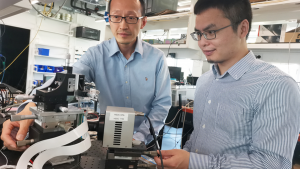Scientists at the Technical University of Denmark have achieved a groundbreaking advancement for lidar systems, developing a new chip-based beam steering technology that significantly optimises lidar.
Lidar (light detection and ranging) systems are essential in many applications, including autonomous driving, free-space optical communications, 3D holography, biomedical sensing and virtual reality. Lidar utilises laser pulses to acquire 3D information about a scene or object.
Now, researchers have potentially eliminated some of the drawbacks of current lidar technology, pioneering a novel chip-based beam steering device that may lead to small, cost-effective, and high-performance lidar.
Hao Hu, the research leader from the Technical University of Denmark, commented: “Optical beam steering is a key technology for lidar systems, but conventional mechanical-based beam steering systems are bulky, expensive, sensitive to vibration and limited in speed.
“Although devices known as chip-based optical phased arrays (OPAs) can quickly and precisely steer light in a non-mechanical way, so far, these devices have had poor beam quality and a field of view typically below 100 degrees.”
The team’s novel chip-based OPA overcomes a range of problems that have limited OPAs. Their technology mitigates a key optical artefact known as aliasing, which means beam steering is achieved over a large field of view while maintaining high beam quality, substantially improving lidar systems.
Hu added: “We believe our results are groundbreaking in the field of optical beam steering. This development lays the groundwork for OPA-based lidar that is low cost and compact, which would allow lidar to be widely used for a variety of applications such as high-level advanced driver-assistance systems that can assist in driving and parking and increase safety.”
Optimising optical phased arrays
OPAs facilitate beam steering by controlling light’s phase profile electronically to form specific light patterns. Traditional OPAs employ a range of waveguides to emit various beams of light, and then interference is applied in the far field (away from the emitter) to form a pattern.
However, due to these waveguide emitters being spaced far apart and generating multiple beams in the far field, an optical artifact known as ‘aliasing’ is created. The emitters need to be closer to avoid aliasing and achieve a 180-degree view. However, this causes strong crosstalk between adjacent emitters and degrades the beam quality.
To overcome this limitation, the team innovated a novel OPA that replaces the multiple emitters of conventional OPAs with a slab grating to create a single emitter, eradicating the aliasing problem because the adjacent channels in the slab grating can be extremely close.
This is not detrimental because it enables the interference and beam formation in the near field (close to the single emitter), meaning light can then be emitted to the far field at the desired angle. Additionally, the researchers applied optical techniques to reduce background noise and other optical artefacts such as side lobes.

A breakthrough for lidar
The scientist developed a special imaging system to assess their novel technology, measuring the average far-field optical power along the horizontal direction over a 180° field of view. The results illuminated that the device could achieve aliasing-free beam steering in this direction, although some beam degradation was observed.
Subsequently, the team tested beam steering in the vertical direction by tuning the wavelength from 1,480nm to 1,580nm, accomplishing a tuning range of 13.5°. Moreover, they demonstrated the versatility of the OPA by using it to form 2D images of the letters D, T, and U centred at the angles of -60°, 0°, and 60°. The team is now working to perform beam steering with a higher resolution and a more extended range.
Hu concluded: “Our new chip-based OPA shows an unprecedented performance and overcomes the long-standing issues of OPAs by simultaneously achieving aliasing-free 2D beam steering over the entire 180° field of view and high beam quality with a low side lobe level.”







